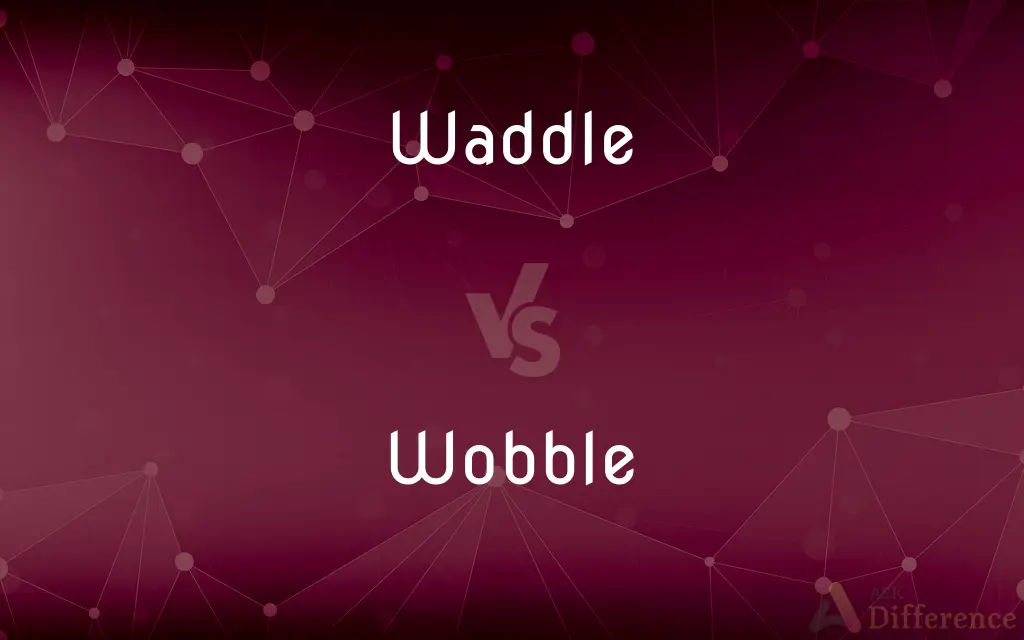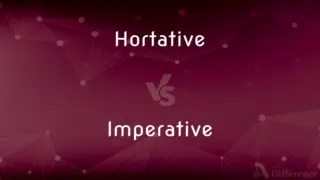Waddle vs. Wobble — What's the Difference?
Edited by Tayyaba Rehman — By Fiza Rafique — Updated on April 5, 2024
Waddle is a specific type of walk characterized by a side-to-side motion, often seen in ducks and penguins. Wobble refers to unsteady, trembling movements, indicating instability or lack of balance.

Difference Between Waddle and Wobble
Table of Contents
ADVERTISEMENT
Key Differences
Waddling is a distinctive walking pattern where the center of gravity shifts from side to side, creating a rolling motion. This movement is commonly observed in animals with short legs relative to their body size, like ducks and penguins, and can also describe a person's walk, especially when balance is distributed unevenly due to body shape or carrying weight. On the other hand, wobbling encompasses a broader range of unsteady movements, not limited to walking. It describes objects, parts of the body, or even abstract concepts like opinions that tremble or move irregularly, signaling instability or fluctuation.
The cause of a waddle often lies in anatomical structure or an attempt to maintain balance while moving forward, making it a relatively controlled and predictable motion. In contrast, wobbling is typically a sign of weakness, poor construction, or external forces acting unpredictably on the object or person, making the motion more erratic and less predictable.
In practical terms, a waddling gait in humans may result from physical conditions affecting the hips or legs, or from temporary situations like pregnancy. Wobbling, however, can be observed in situations ranging from a person trying to stand on one leg, a poorly balanced table, or the uncertain movements of someone on a shaky surface.
Waddling has a certain efficiency in nature, allowing creatures designed for swimming, like penguins, to conserve energy on land. Conversely, wobbling is generally seen as undesirable, indicating a potential fall or failure unless corrected. This distinction highlights the adaptive purpose behind a waddle versus the corrective action often required to stop a wobble.
In human behavior and mechanical devices, the distinction between waddling and wobbling can inform design and intervention. Ergonomic adjustments can help mitigate wobbling in furniture or machinery, while physical therapy can address issues leading to a waddling gait in individuals.
ADVERTISEMENT
Comparison Chart
Definition
A side-to-side motion in walking.
An unsteady, trembling movement.
Associated With
Animals like ducks, penguins; humans in specific cases.
Objects, body parts; indicates instability.
Cause
Anatomical structure, balance while moving.
Weakness, poor construction, external forces.
Predictability
Controlled, predictable motion.
Erratic, less predictable.
Desirability
Efficient in certain animals; may indicate condition in humans.
Generally undesirable, indicating potential for failure.
Compare with Definitions
Waddle
Often due to body structure.
Penguins waddle due to their short legs.
Wobble
Unsteady movement or tremble.
The table wobbled on the uneven floor.
Waddle
Walking with a side-to-side gait.
The duck waddled back to the pond.
Wobble
Can affect objects or body parts.
He wobbled on his feet after the long run.
Waddle
Characterized by a rolling motion.
The toddler waddled across the room.
Wobble
Indicates instability or weakness.
The poorly constructed shelf wobbled under the books' weight.
Waddle
Can indicate balance distribution.
She waddled under the weight of the heavy backpack.
Wobble
Can result from external forces.
The earthquake made the building wobble dangerously.
Waddle
Seen in both animals and humans.
His waddle became more pronounced with age.
Wobble
Requires correction to prevent failure.
They fixed the wobble in the machine with a new part.
Waddle
Walk with short steps and a clumsy swaying motion
Three geese waddled across the road
Wobble
To move or rotate with an uneven or rocking motion or unsteadily from side to side.
Waddle
A waddling gait
I walk with a waddle
Wobble
To tremble or quaver
The child's voice wobbled with emotion.
Waddle
To walk with short steps that tilt the body from side to side.
Wobble
To waver or vacillate in one's opinions or feelings.
Waddle
To walk heavily and clumsily with a pronounced sway.
Wobble
To cause to wobble.
Waddle
A swaying gait
The waddle of ducks.
Wobble
The act or an instance of wobbling; unsteady motion.
Waddle
A squat, swaying gait.
The waddle of a duck
Wobble
A tremulous, uncertain tone or sound
A vocal wobble.
Waddle
(intransitive) To walk with short steps, tilting the body from side to side.
Wobble
An unsteady motion.
The fat man walked down the street with a wobble.
Waddle
(intransitive) To move slowly.
Wobble
A tremulous sound.
There was a wobble on her high notes.
Waddle
To walk with short steps, swaying the body from one side to the other, like a duck or very fat person; to move clumsily and totteringly along; to toddle; to stumble; as, a child waddles when he begins to walk; a goose waddles.
She drawls her words, and waddles in her pace.
Wobble
(music) A low-frequency oscillation sometimes used in dubstep
Waddle
To trample or tread down, as high grass, by walking through it.
Wobble
(genetics) A variation in the third nucleotide of a codon that codes for a specific aminoacid
Waddle
Walking with a waddling gait; walking with short steps and the weight shifting from one foot to the other
Wobble
(intransitive) To move with an uneven or rocking motion, or unsteadily to and fro.
The Earth wobbles slowly on its axis;
The jelly wobbled on the plate
Waddle
Walk unsteadily;
Small children toddle
Wobble
(intransitive) To tremble or quaver.
The soprano's voice wobbled alarmingly.
Wobble
(intransitive) To vacillate in one's opinions.
I'm wobbling between the Liberals and the Greens.
Wobble
(transitive) To cause to wobble.
The boy wobbled the girl's bike.
Wobble
See Wabble.
Wobble
An unsteady rocking motion
Wobble
Move unsteadily;
His knees wobbled
The old cart wobbled down the street
Wobble
Move sideways or in an unsteady way;
The ship careened out of control
Wobble
Tremble or shake;
His voice wobbled with restrained emotion
Common Curiosities
Is wobbling always a bad sign?
Wobbling usually indicates instability or imbalance, which can be problematic for objects and potentially dangerous for people.
What are common solutions for wobbling furniture?
Adjusting leg length, adding stabilizers, or placing the furniture on a more even surface can correct wobbling.
Can waddling be corrected in humans?
Depending on the cause, waddling caused by physical conditions may be improved through therapy or medical intervention.
How can you stop an object from wobbling?
Correcting the balance, strengthening the structure, or securing it on a stable base can stop an object from wobbling.
Are there benefits to a waddling gait in animals?
For some animals, waddling is an efficient way to conserve energy while moving on land, especially for those adapted to swimming.
What causes a person to waddle?
A person may waddle due to anatomical reasons, pregnancy, or carrying a heavy load, affecting balance and walking style.
Is waddling normal in pregnancy?
Waddling is a common walking pattern during pregnancy, often due to changes in posture and weight distribution.
Can both waddling and wobbling be observed in the same individual?
Yes, an individual might waddle due to a specific walking pattern and wobble when balance is compromised, such as standing on one leg.
Can wobbling affect mechanical devices?
Yes, wobbling in mechanical devices can indicate misalignment or wear, often requiring maintenance or repair.
What does it mean if a table wobbles?
A wobbling table usually indicates uneven legs or an uneven surface, requiring adjustment for stability.
Share Your Discovery

Previous Comparison
Hortative vs. Imperative
Next Comparison
Nutmeg vs. MuscatAuthor Spotlight
Written by
Fiza RafiqueFiza Rafique is a skilled content writer at AskDifference.com, where she meticulously refines and enhances written pieces. Drawing from her vast editorial expertise, Fiza ensures clarity, accuracy, and precision in every article. Passionate about language, she continually seeks to elevate the quality of content for readers worldwide.
Edited by
Tayyaba RehmanTayyaba Rehman is a distinguished writer, currently serving as a primary contributor to askdifference.com. As a researcher in semantics and etymology, Tayyaba's passion for the complexity of languages and their distinctions has found a perfect home on the platform. Tayyaba delves into the intricacies of language, distinguishing between commonly confused words and phrases, thereby providing clarity for readers worldwide.















































